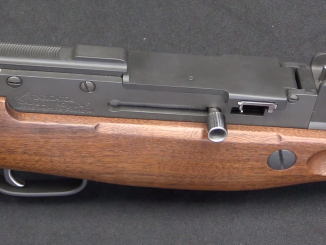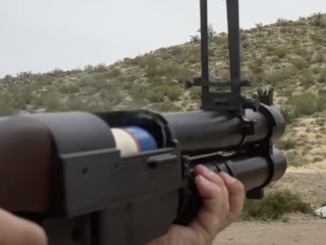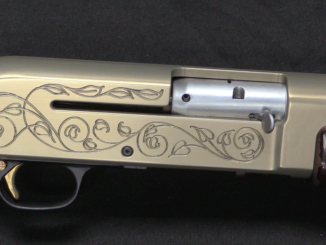This M14 is being sold by Morphys on October 30, 2018.
While Harrington & Richardson was making M14 rifles for the United States military, they were also experimenting with other variations on the design. Among these was the “Guerrilla Gun”, an shortened and lightened M14. The barrel was reduced in length by 4.5 inches and also reduced significantly in diameter, and a special conical flash hider fitted. The intention was to make a version more suitable to small-statured Asian soldiers, and several of these rifles were made in the X-40 range of serial numbers. This particular one was also fitted with a custom made underflowing stock which further lightened the gun as well as making it quite compact. One can only imagine how difficult this configuration would have been to shoot in fully automatic!
This rifle was registered and sold by H&R in the mid 1980s, and it is well provenance to the factory. A previous owner replaced the short barrel with a standard length one as well as a standard stock, and in that configuration it is a quite scarce fully transferrable M14. The short barrel and its fittings (less the flash hider) are still with it, however, and hopefully the next owner will return it to its original form.




“Move over Kalashnikov, now there’s something, uh, ‘meatier?’ ”
Of course numbers of people apparently buy abbreviated M1A self-loading-only versions of the brief U.S. service rifle with a 16-in. barrel with a huge muzzle brake installed… Thereby compromising the one attribute of the M14: long range accuracy, in a correctly-bedded, tuned rifle!
Probably more than a little expensive compared to, say, an M1 or M2 carbine, which is what I dare say a number of combatants in the CIA’s various proxy armies carried early on. Interesting Cold War collectible!
“M1 or M2 carbine”
So far I know these were used during Malayan Emergency (1948-1960)
https://www.iwm.org.uk/collections/item/object/205212402
it would be interesting to known users regarding use in that conflict.
“more suitable to small-statured Asian soldiers”
As side note, Japanese Self-Defense Forces adopted 7,62×51 cartridge dimension-wise equal to 7,62×51 NATO, but with smaller powder charge and produced rifle for it:
http://modernfirearms.net/en/assault-rifles/japan-assault-rifles/tip-64-eng/
while making 2 different but looking same (and thus allowing loading stronger into chamber of weapon for weaker) is generally rather bad idea, Japan at that time was not allowed to be arms exporter, thus it was of lesser concern that it might looks.
Thankfully the Japanese always tested their rifles with really overcharged ammunition before issuing them. The fear was that if domestic ammunition supply ran low and American imported stock replaced it, having a rifle unable to handle strong loads would be a hindrance… or maybe I could be wrong.
The Type 64 was actually only issued to Ground Self-Defense Force infantry units. Among other things, being the size and weight of an FAL or H&K G3 but without a folding or retracting stock, it was hard to get in and out of APCs with.
Its reduced charge round had about the ballistics of the 7.62 x 39, and most officers were of the opinion that it was too much metal for too little performance.
By comparison, most personnel in the Self-Defense Forces who needed a “rifle” were issued M1/M2 carbines, mainly manufactured by Howa Machinery Co. under license from the U.S. under MAP.
The Carbines were the main reason that in spite of numerous SMG development programs, the SDF never adopted an actual SMG until the early 2000s. The SMGs from such companies as Shin Chuo Kogyu were very much typical second and third-generation types, mainly following the model of the Swedish Carl Gustaf M/45, and almost universally chambered for 9 x 19mm.
As such, they all ended up heavier than the Carbine, with shorter range, poorer accuracy and less hitting power than the .30 round, and they really weren’t enough cheaper to make to matter. Plus, the standard service pistol of the SDF was the Colt M1911A1 in .45 ACP.
The carbines and the Type 64 were finally retired with the adoption of the Type 89 rifle (basically a SiG 510 in 5.56 x 45mm) in 1991. This was at the same time as the Colt automatic was retired, replaced by the Type 90 pistol, aka the SiG P225 in 9 x 19mm.
cheers
eon
An artillery officer in the JGSDF once told me over three decades ago that the Type 64 was a good rifle for the Japanese soldier, but complained that because it was made in Japan it had “many small parts.”
The U.S. armed and equipped forces in Asian shooting wars too–the RoKA for example, but also various guerrillas and partisans operating in North Korea, the various Montagnard and Hmong “secret armies” in the Laotian and Vietnamese campaigns, and doubtless others besides. The Garand rifle and BAR were widely used of course, but the carbine was similarly widely distributed.
As for the Kalashnikov, apparently the first one in Western hands was secured in Irian Jaya/ western New Guinea by Dutch special forces in a recovery from Indonesians.
Here’s a question: “H&R Guerrilla Gun” or Hillberg “Liberator” four-barrel shotgun?
Dave;
Given the choice between .30-06 rifles, shotguns, and the M1 carbine, the Philippine guerrillas chose the latter in spite of having significant stocks on M1917 Enfield .30-06 rifles and 12- gauge civilian shotguns of various types. Why?
1. The Carbines were more easily maneuvered in underbrush due to their short OAL.
2. Their range and killing power were more than adequate for most engagements vs. the Japanese, which were generally at 20 to 100 yards, simply because that was about as far as anybody on either side could see in the islands’ jungles. Conversely, the shotguns loaded with buckshot were only effective out to about 30 yards, which gave the Japanese a 50 to 60 yard range advantage in some situations.
3. The ammunition for the carbines was more compact and lighter in weight. More could be carried by the individual soldier and much more could be packed into a U.S. Navy fleet submarine for delivery, compared to .30-06 or 12-gauge. (Stack carbine rounds next to either one and you’ll see what they meant.)
4. Given a hacksaw and a file and a couple of hours’ work, a Carbine could be cut down to as little as 18 inches in length with little loss of effectiveness. The same could not be said for a .30-06 rifle, and shotguns were already being cut down, often to pistol size for concealment.
Note that arguments (2) and (3) were part of the studies that gave rise to the 5.56 x 45mm class of infantry rifles, notably at CONARC in the 1950s. (See “Project Salvo”.)
While the full-power rifle and the 12-gauge shotgun have their attractions for unconventional warfare, the U.S. Carbine is generally accepted as the best “all-around” guerrilla weapon ever designed, once the above-mentioned issues are factored in.
By the way, the French resistance(what there actually was, as opposed to Hollywood’s version) agreed with the Filipinos 100% on the Carbine. So much so that it was a standard item of French police armament for many years after the war, at least partly due to the number of French policemen who had been in the resistance one way or another.
And when the carbines were finally retired in the 1970s, They were for the most part replaced by the very similar Ruger Mini-14 in 5.56 x 45mm.
cheers
eon
The Malay Races Liberation Army used all kinds of WWII-vintage small arms, primarily Japanese and British.
The UK/Commonwealth forces used WWII vintage British equipment like the Sten SMG, the Bren gun, the Lee Enfield rifles and No.5 carbines, but also Australian Owen SMGs, U.S. M1 carbines (pictured in the IWM link), and Browning Auto-5 and Remington 870 shotguns loaded with “SG” or 00 buckshot.
The only combat evaluation of the 12-gauge or “12-bore” in British English that I am aware of came out of triple canopy jungle warfare in the “Malayan Emergency.” It was found that a swift “mag dump” of double ought buck was mighty effective in counter ambush tactics, although reloading was slow.
Some of the militia organized to counter the MRLA in various camps used shotguns too.
Interesting observation re Daweo’s link to the UK site – one of the photos at the bottom shows a British soldier with a Bren gun with its flash hider removed and an Owen gun front handgrip added. Very unusual ‘field modifications’ !
Any rifle is accurate with costly bedding and tuning.
The M14 is not inherently accurate at long range – it’s design and function is a trainwreck. Tood engineers, gunsmiths, and marksmen made it shine when there was no other choice for a US battle rifle.
The best first step at accurizing an M14 is to throw it in the garbage.
For real fun, fire an accurized M-14 next to an out-of-the-box H&K G3. Watch the M-14 shooter get humiliated.
Then shoot an FAL/SLR next to either one. It makes the M-14 shooter feel a little better.
There’s a reason that there are two standard sharpshooters’ versions of the G3 (the SSG-1 and PSG-1), only custom accurized M-14s, and no “sharpshooters'” version of the FAL/SLR, ever.
Ironically, “conventional wisdom” holds that the gas-operated rifles (M-14 and SLR) should be more accurate than the recoil/delayed-blowback action rifle (the G3). But there it is.
cheers
eon
“Ironically, “conventional wisdom” holds that the gas-operated rifles (M-14 and SLR) should be more accurate than the recoil/delayed-blowback action rifle (the G3). But there it is.”
FAL is gas-operated/tilt, thus belong to same group as SVT-40 and thus weapon which might have problems of accuracy, if you want to use it as sharpshooter.
This fact was known (for SVT) at least as early as Great Patriotic War.
Why would a delayed blowback rifle be less accurate than a gas operated one? It is easy to understand why a recoil-operated rifle could be less accurate than gas operated, but gas operation does not seem to have any accuracy advantages over delayed blowback.
The G3 requires precision in its manufacturing so that one roller isn’t bearing all of the load. This contributes to its accuracy. Somewhat like lapping the lugs on a bolt action rifle.
I do find that surprising. The trigger pull on the civilian HK91 aka. G3 I’ve fired had mighty heavy trigger pull. I do like the iron sights set-up for it.
Interesting observations.
As for the difference in weight for the carbine vs. the .30-06: Oh yes! That is quite a difference! I know that some French forces whose job was not to get into firefights within Nato used the M1A1 until well past its “use by date” and that there were any number of tests done by the French on whether or not the 7.62x33mm might not be the new au courant du jour service cartridge since everyone would, in essence, be crewing one or another crew served weapon or vehicle or what-have-you. Also the basis–along with the German 7,9x33mm kurz cartridge–for any number of experiments, including a mini-CETME roller-locked carbine.
As for the best guerrilla gun ever devised, I’m going to have to give the nod to the “boring” because ubiquitous choice: the Kalashnikov.
Although I do think many laymen/ non-gun-people would be surprised at what other arms were used in most guerrilla wars.
The most popular fighting rifles in Mexico’s “Revolution every day at 4PM” period? Winchester lever-actions in .44-40 and .30-30. Simple, reliable, accurate, and even the .30-30 held one more round than the Federal army’s Mauser or Mondragon bolt-actions.
As for power, an old lawman’s rule of thumb is,
“Deer rifles make decent fighting rifles. If it will kill a deer, it will kill a man.”
.44-40s and .30-30s have killed a lot of deer over the last century or so.
cheers
eon
Carabina treinta y treinta:
https://www.youtube.com/watch?v=gI4v_8gjW04
There was apparently also M14 in paratrooper guise, for comparison see here:
https://www.gunauction.com/buy/14383853
Auction purports it to be an Italian BM-59 parachitists or Alpine/mountain troop stock, I think.
Following is not related to article (if not interested, disregard).
Now, this is real “juicy” news. According to this article, SOCOM invited U.S. manufacturing companies to copy (no kidding) old Soviet machine gun designs: 7.62 PKM and 12.7 NVS
https://topwar.ru/148223-streljajuschij-kontrafakt-ssha-vorujut-starye-sovetskie-tehnologii.html
(click on top ribbon and activate translate function)
It looks no one in SOCOM knows that Poles already “invented” their own version of PKM https://en.wikipedia.org/wiki/UKM-2000
All it needs is to buy Polish license.
According to the Russian article, Purple Shovel already bought blueprints of KT-7.62 to the Ukrspecexport for $267.000.
With that being said I must note that UKM-2000 is heaver than PKM and at same time sports shorter barrel, for more data see: http://modernfirearms.net/en/machineguns/poland-machineguns/ukm-2000-2/
“All it needs is to buy Polish license.”
Lets see, my calendar say it is 2018, they are showing interesting in PKM machine gun, which is in production since 1969, or to use U.S. perspective time when Lyndon B. Johnson was president. You might need some patience – if they will maintain such speed, they will become interested in UKM2000 around 2049.
“12.7 NVS”
NSV, from names of designers: Nikitin Sokolov Volkov, Soviet designation are of order of joining, so NVS is counter-factual as Volkov joined when Nikitin and Sokolov were already working together.
Also NSV is now in processing of being phased out from service in Russian forces in favor or KORD firing same cartridge, not this doesn’t mean NSV is flawed and it would be possibly still in usage, if not fact production plant was inside Soviet Union, but is not inside Russia.
Anyway, as side note NSV firing NATO-compliant 12,7×99 already exist, guess who made it: http://www.zmt.tarnow.pl/wordpress/en/item/127-mm-wielkokalibrowy-karabin-maszynowy-wkm-bm/
Also progress in comparison to PKM, even if small – 1971 year
I spent more than hour yesterday reading about Polish PK modifications. It tells me couple of things. One in that the Russian guns are not as ‘simple and rudimentary’ as they are often labeled. The next thing is that depending on commitment and intermittent effort, it takes considerable amount of work to “redesign” known weapon. In some instances (as was case with Remington Bushmaster which was initially meant as upgrade to M16) it is better to start off fresh.
One of good sources on detail changes/ redesign is article by well known contributor to debates on FW Mr. L.Erenfeicht http://www.sadefensejournal.com/wp/?p=820
Without seeing actual gun, my feel is that because the type of feed known as push-thru common on western MGs there was need to proceed with cartridge little more forward before is chambered thus increase receiver’s length. This is kind of proof that the PKM feed was initially very efficient from space use point of view. It certainly looks PKM will in its PKP(Pecheneg) iteration live on long time to come.
“…there was need to proceed with cartridge little more forward …” and also because of new, forward located barrel lock nut.
The PKP actually does not replace the PKM in the tripod-mounted medium machine gun role (the former lacks the quick change barrel important in that role), so even the basic PKM probably has a long future in the Russian Army. It is still offered for export as well.
As said before, PKP is not supposed to replace totally PKM.
Anyway in 1980s there was programme (codename Гашетка) which was about created machine gun for new 6×49 cartridge. One of competitors is described here:
http://modernfirearms.net/en/machineguns/russia-machineguns/unificirovannyj-6mm-eng/
though its designation is not given and which is АО-64, it is gas-operated, although unlike PKM locking is against barrel, not against receiver.
Available feed options: belt 75, belt 100, belt 200.
Other designs:
ТКБ-0170 from Tula: https://raigap.livejournal.com/566660.html
gas-operated, accept belts and 100-round pan magazines (when 2 option is used, magazine is below weapon)
[Designation unknown] from Izhevsk: https://raigap.livejournal.com/566980.html
LINKS, often overlooked, but important from point of view or machine gun. And additionally if you did not care enough you might end with M85C: http://modernfirearms.net/en/machineguns/u-s-a-machineguns/m85-eng/
and links to M2HB, which would not work.
When I was in Viet Nam nearly 50 years ago, I came across an M14 which had been captured from the VC. It had been shortened by cutting off the barrel just ahead of the gas cylinder. It had no front sight, which I suppose limited its usefulness. Did not have an opportunity to shoot it, but did with another M14 – I remember it being nearly uncontrollable in full auto, but I suppose one would get better with practice!
In terms of shape, the folding M14 stock foreshadows the one used on the A-Team/Knight Ridder Ruger Mini-14 except that the M14 version folds completely under the receiver instead of along the side but low enough not to block the bolt’s line of movement.
I would like to know what an origional M14 would sell for…?..anyone have an idea…?…thank u ,Brian